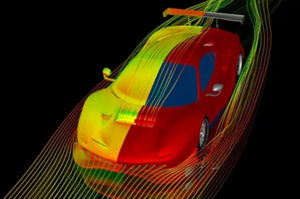
Quality software Computation Fluid Dynamics Analysis CFDcomputational fluid dynamicsengineering

Add to favorites
Compare this product
Characteristics
- Function
- quality, CFD, computational fluid dynamics, engineering
- Applications
- fluid flow, mechanical, electric, for automotive applications, chemical, battery, fuel
Description
Computational fluid dynamics (CFD) is the science of using computers to predict liquid and gas flows based on the governing equations of conservation of mass, momentum, and energy. Fluids are all around us and sustain our lives in endless ways. The vibrations in your vocal cords generate pressure waves in the air that make speech possible, as well as hearing the spoken words. Without fluids, your tennis ball’s topspin would be meaningless, and your airplane wouldn’t generate any lift. Through CFD, we can analyze, understand, and predict the fluids that make up nearly every part of our world.
Examples of Computational Fluid Dynamics
CFD is used wherever there is a need to predict fluid flow and heat transfer, or to understand the effects of fluid flow on a product or system. CFD analyzes different properties of fluid flow, such as temperature, pressure, velocity, and density, and can be applied to a broad range of engineering problems across industries, including:
Aerospace and Defense: CFD makes it possible to model the airflow around aircraft to predict lift and drag, known as external aerodynamics. This is important as companies look to optimize aircraft designs for improved performance and decreased fuel usage. CFD can also simulate complex systems within the aircraft's interior, such as cabin air circulation, to predict air quality. Key applications include Avionics cooling, aero-optics, external aerodynamics, cabin HVAC, and propulsion.
Automotive: In electric vehicles, where e-motors and battery electrochemistry create complex intersections between mechanical, chemical, and electrical engineering
VIDEO
Catalogs
No catalogs are available for this product.
See all of ANSYS‘s catalogsRelated Searches
- ANSYS automation software
- ANSYS management software
- ANSYS analysis software
- ANSYS process software
- ANSYS control software
- ANSYS CAD software
- Real-time software solution
- Online software
- ANSYS design software
- ANSYS 3D software
- Monitoring software solution
- Interface software
- Measurement software
- ANSYS industrial software
- ANSYS quality software
- ANSYS simulation software
- Visualization software solution
- ANSYS automated software
- ANSYS development software
- Network software solution
*Prices are pre-tax. They exclude delivery charges and customs duties and do not include additional charges for installation or activation options. Prices are indicative only and may vary by country, with changes to the cost of raw materials and exchange rates.












